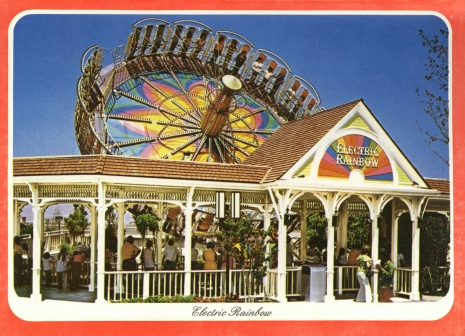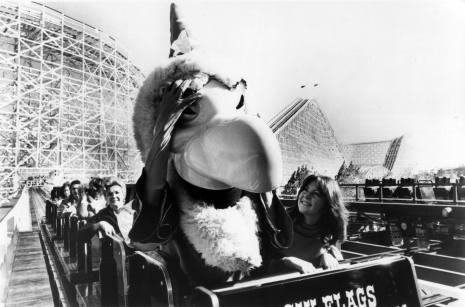
On an incredibly hot memorial day weekend in 1971, Magic Mountain opened in Valencia, California just 18 months after construction began. The “theme” of this theme park was not entirely clear and it only had one roller coaster, however the park’s other offerings—the fireworks, rides, laser shows, arcade games, and nightly concerts—made “fun, magic, and rock ‘n’ roll” the name of the game. By the time the park was sold to Six Flags at the end of the decade, Magic Mountain had cemented a place in rock ‘n’ roll history by giving many young Southern Californians their very first live concert experience. Its three venues (7-Up / Dixi Cola Showcase Theatre, The Gazebo, and Kaleidoscope) were home to many great acts such as Fleetwood Mac, The Carpenters, Sonny & Cher, The Jackson 5, The Everly Brothers, and KISS who attracted a long-haired, beer can drinking parking lot crowd that didn’t meet Disneyland’s strict dress code and could afford the $5 admission price.

Sonny & Cher performed nightly from Sept 2nd-12th, 1971 at Magic Mountain’s 7-Up Showcase Theatre
When it first opened Magic Mountain secured a short-term deal from Warner Brothers to use their Looney Tunes characters, however when that agreement expired in 1972 a lineup of very unmemorable troll characters were introduced: Bloop, Bleep, King Troll (aka King Blop) and the Wizard. These bizarre, colorful, psychedelic looking walk-around characters became the most recognizable symbols of the park throughout the ‘70s. They greeted guests, posed for photographs, and appeared on all manners of merchandise and advertising before being discontinued in 1985.

“Trolls & Fountain” 1977 Magic Mountain postcard
By the mid-1970’s the park begun introducing faster and scarier rides such as The Electric Rainbow, Galaxy, and Jolly Monster. However, it was the Great American Revolution (the first modern, 360-degree steel looping coaster) in 1976 that gave the park its first real thrill factor. At the time Universal was filming a disaster-suspense movie called Rollercoaster about a young extortionist (played by Timothy Bottoms) who travels around the U.S. planting bombs on roller coasters promising horrific casualties to those who don’t meet his one million dollar ransom. The film’s climactic final sequence takes place during a huge rock concert celebrating the grand opening of Revolution. While teen-idol fan magazines Tiger Beat and Sixteen reported to their readers that the Scottish glam-rock band the Bay City Rollers were to perform in this film it was actually Los Angeles’ own Sparks who accepted the role having just relocated back to L.A. from England.
Sparks were documented on the big screen prior to their breakthrough commercial success during a strange transitional period for the band when they briefly dropped their quirkiness and demanded to be taken seriously. Concerned at the time that their music may have become stale, the Mael brothers left their synthesizers behind for a more “American” guitar sound on their Rupert Holmes produced album Big Beat. Although Rollercoaster was a modest success despite fierce competition from Star Wars at the box office that summer, Ron & Russell Mael of Sparks now look back upon the film with embarrassment. “Yes, you did see Sparks performing ‘Big Boy’ and ‘Fill’er Up’ in the film Rollercoaster during your last airplane trip,” said Russell Mael in the September 2006 issue of Mojo Magazine. “No, we didn’t know that the film was going to turn out like that. Rollercoaster movie proves that you have to be continually careful of what you do… You never know what’s going to last and what’s going to fall by the wayside, and man, does that last!” Sparks’ cameo in Rollercoaster is brief but fun and energetic, especially when Ron Mael gets rowdy and smashes his piano stool on the stage.

Russell Mael of Sparks performing in front of Revolution in the 1977 disaster film ‘Rollercoaster’
In 1978 at the height of KISS’ massive popularity, Hanna-Barbera Productions produced a made-for-television movie for NBC titled Kiss Meets the Phantom of the Park. Filmed on location at Magic Mountain, the film’s poor script revolved around an evil inventor living underneath the theme park whose nefarious plans are thwarted by an other-galactic rock ‘n’ roll group with superpowers (played by KISS). Despite the fact that all four members were given crash courses on acting, much of the dialogue recorded was unusable and had to be re-dubbed in post production. Ace Frehley was said to have become increasingly frustrated with the long periods of downtime normally associated with filmmaking and stormed off the set one day leaving his African American stunt double to finish his scenes (which made for perhaps one of the most noticeable and unintentionally hilarious continuity errors in the history of cinema). KTNQ’s “The Real” Don Steele (one of the most popular disc jockeys in the U.S.) gave away 8,000 tickets to see KISS perform live at the Magic Mountain parking lot which was filmed for the movies big dramatic rock ‘n’ roll concert ending.
KISS use their superpowers to defeat two robotic cats inside the Colossus rollercoaster, a scene from the 1978 movie Kiss Meets the Phantom of the Park
In 1979, Avco-Embassy released Kiss Meets the Phantom of the Park theatrically in Europe under the title Attack of the Phantoms. After decades of only being available as an out-of-print VHS tape, the European version is finally available and digitally restored on DVD as part of Kissology Volume Two: 1978–1991 (a collection of concerts and television appearances). A 1979 episode of the live-action Wonder Woman TV series titled “The Phantom Of The Roller Coaster” follows a strangely similar plot involving a napalm explosion monster-freak who lives in the control room underneath the park. The two-part episode, of course, concludes with Lynda Carter pulling together two ends of Revolution coaster (known in this storyline as the “Super Loop”) with all her strength, thus saving the day by preventing a disastrous roller coaster accident. Other examples of Magic Mountain seen on film and television in the ‘70s includes Van Nuys Blvd, On the Air Live with Captain Midnight, CHiPs, The Bionic Woman, the children’s game show Way out Games (a wild and sloppy game show which later became the inspiration for Double Dare), and the 1979 HBO Special 60’s Rock Scrapbook.

Wonder Women saves Revolution in a 1979 episode titled “The Phantom Of The Roller Coaster”
The Landrum Dance Theatre at Magic Mountain from the 1979 HBO Special “60’s Rock Scrapbook”
Unfortunately, the fun and magic thrills of the park gave way to some very serious accidents in the ‘70s, many of which resulted in death. In January of 1978, a mechanic working on the Grand Prix attraction died when one of the cars fell on top of him, and his body was discovered the next morning by his own father who had gone looking for him. The following month, two newlyweds plunged 50 feet to the ground after violently rocking back and forth on the Eagle’s Flight sky ride. Later that same year, a 20-year-old woman flew out of the brand-new Colossus roller coaster after not being securely fastened into her seat. Perhaps the most notable incident was one involving future Academy Award-nominated actress Debra Winger, who sustained a serious on-the-job injury at Magic Mountain at the age of seventeen. While Debra was in full costume as the walk-around troll “Bleep,” she was being driven to a location in the park in a utility vehicle when she suddenly “went out the back end.” She suffered a cerebral hemorrhage and was left partially paralyzed and blind for ten months, having initially been told by doctors that she would never see again.
Each of these incidents led to significant improvements in safety, however, in 1979 owners Newhall Land decided to walk away from the theme park business altogether. They sold the park to the Time Warner media company for $51 million and in 1980 it became known as Six Flags Magic Mountain. Ticket prices began to rise significantly to keep up with the increasing insurance costs, the trolls and wizards disappeared, the Looney Tunes returned, and the rock bands were replaced with more family friendly entertainment. Sandra D. from Valencia spent many summers at Magic Mountain in the ‘70s and recalled how the speakers throughout the grounds would blast “Saturday in The Park” by Chicago every single midnight at closing time. It was the end of an era.
This 1979 TV ad for Coke and Magic Mountain promotes “The Great Rock & Roll Time Machine”

Built in 1974, The Electric Rainbow attraction has now been renamed “Wonder Woman: Lasso of Truth”

Psychedelic Magic Mountain Postcard featuring Galaxy, the Circus Wheel, and the fountain at the bottom of Valencia Falls

“Swiss Twist” A Schwarzkopf Bayern Kurve bobsled ride that was discontinued in 2008

Valerie Bertinelli and the Wizard ride the New Colossus in 1979

Gambi, the 400 lb. man-loving tiger at Magic Mountain’s Children’s Farm

A Magic Mountain fold-out brochure from 1975 that showed off Santa Clarita’s lush landscaping

King Troll, Bleep, the Wizard, and Bloop frolic with children in front of “Das Alpenhaus” which served draft beer and later became the Mooseburger Lodge
Special thanks to: Santa Clarita Valley History, Vintage Disneyland Tickets Blog, Gorillas Don’t Blog